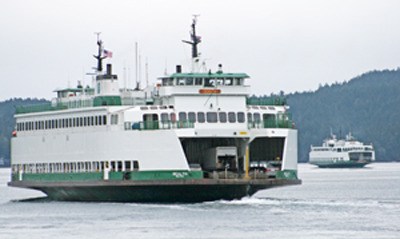Those who travel by ferry in the San Juans will likely be able to do what they’ve always done at any hotel or restaurant, come this time next year: make a reservation.
Washington State Ferries Assistant Secretary David Moseley last week said confidence that a reservation system could work in the islands is ebbing among members of a local group tasked with helping Ferries establish such a system for its San Juan sailings. That’s largely because, he said, the original concept for that system has been scuttled.
“The effort as it stands today is bearing fruit,” Moseley said. “There’s a concept that’s been agreed upon that people think will work.”
The latest concept no longer would require those making reservations to be tied to a WSF frequent-user program, such as its Premier Account, a popular program with riders down sound, and would allot a percentage of automobile space for reservations made well in advance, those made closer to the time of a particular sailing, and then a portion reserved for those traveling without reservation at all.
San Juan Ferry Advisory Committee Chairman Jim Corenman said the biggest concerns with the original concept were the “frequent user” aspect and how to manage a reservation system for residents who are not making travel plans months in advance.
“They took that off the table and what we’re looking at now is more like rolling out reservation space in a couple of phases,” he said.
Moseley cautioned that a final decision on what a reservation system would look like for San Juan routes has yet to be reached. Still, he said that momentum for what has in the past been a hotly debated and sometimes controversial topic appears to be headed in a constructive, positive direction.
The status of San Juans’ reservation system is one of several WSF-related topics discussed at a Dec. 4 community meeting hosted by Ferries in Friday Harbor, and streamed live by video on the San Juan County website. Ferries received $5.8 million from the state Legislature in early 2010 to implement a reservation system, and it remains a key goal in the agency’s long-range plan. Expanded use of reservations is expected to reduce the need for building bigger terminals and parking areas, saving the state an estimated $280 million, while also reducing emissions from idling autos and benefitting businesses in ferry-dependent communities as well.
Meanwhile, Moseley noted deliberations are still under way in Olympia over a statewide transportation funding package, as part of a “special” legislative session tied to the state’s 2014-15 biennial budget. Ferries would receive a bit of a revenue boost under proposals offered up by the House and by the Senate, but it would still require supplemental funding to cover a shortfall in the operations side of the agency’s expenditures, which typically totals roughly $132 million over two years, given the amount of service Ferries currently provides.
“The fact that they’re still talking is a good sign,” he said of the negotiations.
Moseley said the ferry system is also making headway in its three-year exploration of converting from diesel to liquefied natural gas as a primary fuel source, a cheaper and cleaner source of fuel used extensively in Norway and in Sweden to power ferries. The ferry system burns roughly 17.5 million gallons a year, and its fuel costs have nearly doubled over the past 12 years, consuming roughly 11 percent of the agency’s operational expenses in 2000, and 23 percent by 2012.
“Fuel is the fastest growing part of our operations budget,” he said.
Although Ferries earlier received approval by the United States Coast Guard on a preliminary LNG design, giving WSF a green light to delve deeper into a potential conversion, another round of Coast Guard approval on safety, risk mitigation and operating plans would be need even before WSF decides whether to invest in retrofitting existing boats or equipping new boats with LNG engines.
“A final decision has not been made but hurdles continued to be scaled,” Moseley said.
Construction of two new boats, both with 144-vehicle carrying capacity, is on time and “significantly” under budget, Moseley said. The “Tokitae” is slated to begin service sometime this summer and the “Samish” should be ready in spring 2015. Should funding arrive for a third 144-auto, he said that boat would be in the San Juans full time.




